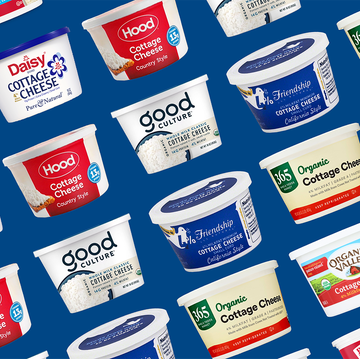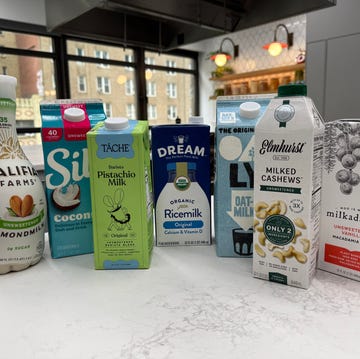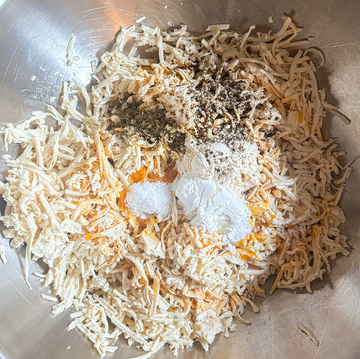1Thailand; Basil Seed Drink
 <a href="http://www.flickr.com/photos/go_jake/529288580/" target="_blank">Jake Yeagley</a>
<a href="http://www.flickr.com/photos/go_jake/529288580/" target="_blank">Jake Yeagley</a>This drink might look like it's full of tiny tadpoles, but those little jelly-covered bits are actually basil seeds. Basil seed drinks are often also found with honey, lemon, or other flavorings, but the tiny seeds are always suspended in the liquid, similar to another well-known Asian treat, bubble tea.
If you're lucky, you just might find this drink at a few specialty or Asian food markets in the U.S.
2Korea; Boiled Silkworm Larvae
 Courtesy of flickr user <a href="http://www.flickr.com/photos/qonita/4163059655/" target="_blank">qonita</a>
Courtesy of flickr user <a href="http://www.flickr.com/photos/qonita/4163059655/" target="_blank">qonita</a>Also known as beondegi in Korea, boiled silkworm larvae or pupae are considered a delicacy. The word beondegi literally translates to "chrysalis" or "pupa" in English, and the insects are usually eaten as a snack. They are often sold by street vendors or in bars. It's also possible to purchase the canned larvae in some grocery stores, but the treat is most often consumed at drinking establishments, restaurants, or on the street. Though in some parts of the world this might seem like an unusual choice of snack, in many of Asia's great silk-producing countries, the larvae are eaten so they aren't wasted — the silkworms must be dropped in hot water as part of the silk production process. In other parts of Asia, like in China and Vietnam, you're more likely to come across them fried.
Advertisement - Continue Reading Below
3China, Hong Kong, Macau, Southeast Asia, Taiwan; Grass Jelly
 Courtesy of flickr user <a href="http://www.flickr.com/photos/sling_flickr/5905189574/" target="_blank">sling@flickr</a>
Courtesy of flickr user <a href="http://www.flickr.com/photos/sling_flickr/5905189574/" target="_blank">sling@flickr</a>Grass jelly (also sometimes called leaf jelly) is made from the stalks and leaves of a plant related to mint. It's often served with other ingredients or as a component to a dessert, rather than on its own. Here, it's pictured atop a bed of sweet tofu.
4Japan; Wasabi-Flavored Beer
 Courtesy of flickr user <a href="http://www.flickr.com/photos/azn_wildcat1976/1394182693/" target="_blank">akapensensei</a>
Courtesy of flickr user <a href="http://www.flickr.com/photos/azn_wildcat1976/1394182693/" target="_blank">akapensensei</a>There are more and more craft and specialty-flavored beers out there every year. This wasabi-flavored brew from Japan may be one of the most unique. Wasabi is a flavor commonly found in Japanese cuisine, but this bright green beer incorporates the spicy, horseradish-like root directly into the brew, giving it a serious kick in addition to a vivid green color. It might look more like a St. Patrick's Day concoction, but this bold beer is anything but a wimpy, food-coloring-enhanced beverage for wannabe Irish college students. If you're able to get your hands on a pint, it's sure to wake your tastebuds (and your sinuses) right up.
Advertisement - Continue Reading Below
5Japan; Cubic Watermelon
 Courtesy of flickr user <a href="http://www.flickr.com/photos/furdis/7698333572/" target="_blank">furdis</a>
Courtesy of flickr user <a href="http://www.flickr.com/photos/furdis/7698333572/" target="_blank">furdis</a>This really is a watermelon — just one that's been grown into a very convenient cube shape. Space in large Japanese cities is extremely limited, so watermelon growers there came up with an innovative way to ensure that lovers of the sweet melon could find a way to fit the usually large, oblong fruit into their small refrigerators. They forced it to grow into the shape of a more compact, easier-to-stack cube. Originally conceived by an enterprising farmer on Japan's Shikoku island, the watermelons are simply grown in glass boxes, confining the fruit to that space as they grow and forcing them to (naturally) form into cubes.
6Northeast U.S.; Canned Bread
 Courtesy of flickr user <a href="http://www.flickr.com/photos/wiless/2309134774/" target="_blank">Will</a>
Courtesy of flickr user <a href="http://www.flickr.com/photos/wiless/2309134774/" target="_blank">Will</a>This old New England staple might seem odd to those unfamiliar with it, but in the Northeast United States, canned brown bread is as ubiquitous as the usual bagged variety. B&M has been making canned bread in the region since the mid-1800s. Cooked by steaming, canned bread will, unsurprisingly, keep longer than fresh bread. It has a moist, dense texture, and it's also sold with raisins for extra sweetness and chewiness. It can be sliced and eaten straight from the can, or toasted and finished with butter, jams, cheeses, or other toppings.
Advertisement - Continue Reading Below
7Japan; Pepsi Blue Hawaii
 Courtesy of flickr user <a href="http://www.flickr.com/photos/kanonn/2589424192/" target="_blank">kanonn</a>
Courtesy of flickr user <a href="http://www.flickr.com/photos/kanonn/2589424192/" target="_blank">kanonn</a>Pepsi Blue Hawaii, despite its name, was released in limited quantities in Japan, not Hawaii. Though blue, the bright, fruity soda's main flavor notes are actually pineapple and lemon.
8China and Thailand; Soft-Shell Crab and Seaweed Pringles
 Courtesy of flickr user <a href="http://www.flickr.com/photos/leleuzis/5723915925/" target="_blank">Lelê Breveglieri</a>
Courtesy of flickr user <a href="http://www.flickr.com/photos/leleuzis/5723915925/" target="_blank">Lelê Breveglieri</a>We're all familiar with Pringles brand potato chips — the popular snacks, sold in an easy-to-tote and very recognizable tube, are available the world over. But there are some distinctive Pringles flavors out there that aren't available in the U.S. Seaweed Pringles (which are appropriately bright green) and a soft-shell crab variety are only widely sold in a few select countries in Asia, like China and Thailand. If you're abroad in Asia, also look out for the company's
Street Food Series of flavors, which include Curry Fish Balls in Hong Kong, Bangkok-style Grilled Chicken Wings, and Indonesian Chicken Satay.
Advertisement - Continue Reading Below
9Japan; Pepsi Azuki
 Courtesy of flickr user <a href="http://www.flickr.com/photos/smplcmpsr/4081124392/sizes/z/" target="_blank">smplcmpsr</a>
Courtesy of flickr user <a href="http://www.flickr.com/photos/smplcmpsr/4081124392/sizes/z/" target="_blank">smplcmpsr</a>Sweetened red bean paste, made from azuki (also known as adzuki) beans, is a common ingredient in many popular Japanese desserts, like mochi. But this limited-edition soda from global brand Pepsi attempted to incorporate the flavor of the sweetened beans right into the beverage.
10Tasmania; Tasmanian Scallop Pie
 Courtesy of the Tasmanian Scallop Pie Company
Courtesy of the Tasmanian Scallop Pie CompanyIt's only natural that Tasmania — an island located off of Australia's southern coast — would be famous for its seafood. Cool ocean currents in that part of the world create the perfect environment for a multitude of creatures to thrive, including crabs, lobster, oysters, abalone, and of course, scallops. Scallop pie is a savory pie much like a pot pie, found all across Tasmania, and has been a popular dish since the 19th century. The mild, creamy filling typically found inside a pot pie is usually spiced with curry, like this one from the Tasmanian Scallop Pie Company.
Advertisement - Continue Reading Below
11Sweden; Rose Hip Soup (Nyponsoppa)
 Courtesy of flickr user <a href="http://www.flickr.com/photos/mararie/165940597/" target="_blank">mararie</a>
Courtesy of flickr user <a href="http://www.flickr.com/photos/mararie/165940597/" target="_blank">mararie</a>Popular throughout Sweden, but not even on store shelves in most of the rest of the world, rose hip soup (or nyponsoppa) can be served as a soup or as a beverage, or even sometimes as a dessert with a bit of milk, cream, or ice cream. Rose hips are high in vitamin C, so this vividly colored delicacy would be a great choice when you're feeling under the weather, too — if only you can find yourself some.
12Sweden and Finland; Filmjölk/Plimä
 Courtesy of flickr user <a href="" target="_blank">katjaelina</a>
Courtesy of flickr user <a href="" target="_blank">katjaelina</a>In Scandinavian countries like Sweden (where it's called filmjölk) and Finland (where it's called piimä), soured milk is a popular breakfast item or snack. Sour milk might sound like something you shouldn't even think about eating, but the truth is that it's actually quite good for you. Thickened to a texture of thin, creamy yogurt, it contains the kind of cultures and good bacteria that keep a digestive system healthy. Slightly acidic and sour tasting, the sometimes thinner piimä can be drunk or used in place of buttermilk for marinades or dressings, while filmjölk is often eaten more like a yogurt with fruit or other toppings (though it is not at all sweet on its own, and the two variations share the same sour flavor).
Advertisement - Continue Reading Below
13South Africa; Bobotie
 Courtesy of flickr user <a href="http://www.flickr.com/photos/keatonviolet/8287555421/" target="_blank">keatonviolet</a>
Courtesy of flickr user <a href="http://www.flickr.com/photos/keatonviolet/8287555421/" target="_blank">keatonviolet</a>Bobotie is a South African specialty. Usually made with ground meat and an eggy, custardy topping, this casserole is an adaptation of a traditional Indonesian dish called bobotok, which is thought to have originally been brought to South Africa by Dutch colonists and traders. Today, the modern version of the dish is most commonly made with minced beef or lamb, often includes curry powder, and is served with a spicy sambal, making it uniquely South African.
Advertisement - Continue Reading Below
Advertisement - Continue Reading Below
Advertisement - Continue Reading Below


























